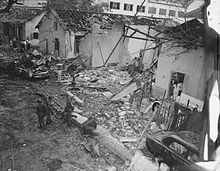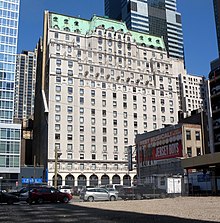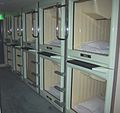Portal:Hotels
Portal maintenance status: (July 2022)
|
The Hotels Portal


A hotel is an establishment that provides paid lodging on a short-term basis. Facilities provided inside a hotel room may range from a modest-quality mattress in a small room to large suites with bigger, higher-quality beds, a dresser, a refrigerator, and other kitchen facilities, upholstered chairs, a television, and en-suite bathrooms. Small, lower-priced hotels may offer only the most basic guest services and facilities. Larger, higher-priced hotels may provide additional guest facilities such as a swimming pool, a business center with computers, printers, and other office equipment, childcare, conference and event facilities, tennis or basketball courts, gymnasium, restaurants, day spa, and social function services. Hotel rooms are usually numbered (or named in some smaller hotels and B&Bs) to allow guests to identify their room. Some boutique, high-end hotels have custom decorated rooms. Some hotels offer meals as part of a room and board arrangement. In Japan, capsule hotels provide a tiny room suitable only for sleeping and shared bathroom facilities.
Hotel operations vary in size, function, complexity, and cost. Most hotels and major hospitality companies have set industry standards to classify hotel types. An upscale full-service hotel facility offers luxury amenities, full-service accommodations, an on-site restaurant, and the highest level of personalized service, such as a concierge, room service, and clothes-ironing staff. Full-service hotels often contain upscale full-service facilities with many full-service accommodations, an on-site full-service restaurant, and a variety of on-site amenities. Boutique hotels are smaller independent, non-branded hotels that often contain upscale facilities. Small to medium-sized hotel establishments offer a limited amount of on-site amenities. Economy hotels are small to medium-sized hotel establishments that offer basic accommodations with little to no services. Extended stay hotels are small to medium-sized hotels that offer longer-term full-service accommodations compared to a traditional hotel. (Full article...)
Recognized articles - load new batch
-
Image 1The Shamrock was a hotel constructed between 1946 and 1949 by wildcatter Glenn McCarthy southwest of downtown Houston, Texas next to the Texas Medical Center. It was the largest hotel built in the United States during the 1940s. The grand opening of the Shamrock is still cited as one of the biggest social events ever held in Houston. Sold to Hilton Hotels in 1955 and operated for over three decades as the Shamrock Hilton, the facility endured financial struggles throughout its history. In 1985, Hilton Hotels donated the building to the Texas Medical Center and the structure was demolished on June 1, 1987. (Full article...)
-
Image 2The Hotel Polen fire occurred on 9 May 1977 in Amsterdam, the Netherlands. The conflagration destroyed the Hotel Polen (Hotel Poland), a five-story hotel in the centre of the city which had been built in 1891, as well as the furniture store on the ground level and a nearby bookstore. Many of the tourists staying at the hotel (of whom the majority were Swedes) jumped to their deaths trying to escape the flames. Upon their arrival, the fire department used a life net to help people escape, but not everyone could be saved. The incident resulted in 33 deaths and 21 severe injuries. The cause of the fire is unknown. In 1986, the Polish-born artist Ania Bien created a photographic installation based on the fire which compared it to the Holocaust.
The hotel was located between the Kalverstraat (no. 15–17) and the Rokin (no. 14), near the present day Madame Tussauds. Its place is now occupied by the Rokin Plaza, originally an office building, which today houses several fashion shops. (Full article...) -
Image 3The tower, with the Columbus Circle globe in front
The Trump International Hotel and Tower, originally the Gulf and Western Building, is a high-rise building at 15 Columbus Circle and 1 Central Park West on the Upper West Side of Manhattan, New York City. It was originally designed by Thomas E. Stanley as an office building and completed in 1970 as the headquarters of Gulf and Western Industries. In the mid-1990s, a joint venture composed of the General Electric Pension Fund, Galbreath Company, and developer Donald Trump renovated the building into a hotel and residential tower. The renovation was designed by Philip Johnson and Costas Kondylis.
The Trump International Hotel and Tower is 583 ft (178 m) tall and has contained 44 physical stories since it was built. The building originally had an aluminum-and-marble facade and was surrounded by a public plaza on Broadway and Central Park West. There was a movie theater and shops in the basement as well as a restaurant on the top floor. After the building was renovated, a glass facade was installed. The lower portion of the tower is used as a hotel, while the upper floors house residential condominiums. (Full article...) -
Image 4
Hotel Valley Ho is a historic hotel in Scottsdale, Arizona. Also called the Valley Ho and, for 28 years, the Ramada Valley Ho, the hotel was originally designed by Edward L. Varney. It first opened in 1956 with a forward-looking and futuristic design. Movie stars and famous baseball players stayed, and the building quickly became known for its trendsetting guests and its fashionable atmosphere. The success of the venture resulted in expansion in 1958, with two additional two-story wings of guest rooms extending to the north. Though initially proposed by Varney, a central tower of guest rooms, rising over the lobby, was not built.
The property was bought by the Ramada hotel chain in 1973, and was redecorated to cover the 1950s design, seen at the time as outdated. No longer in vogue, but centrally located, the hotel remained prominent for years, and hosted conferences, business meetings, and vacationers. Under Ramada management, however, the property began to show a lack of maintenance, and its popularity declined. It closed in 2001 and its demolition was considered when no purchase offers were received. Admirers of the hotel's exemplary architecture and its local history rallied to save it, and it was placed on the Scottsdale Historic Register. (Full article...) -
Image 5
The Knickerbocker Hotel is a hotel at Times Square, on the southeastern corner of Broadway and 42nd Street, in the Midtown Manhattan neighborhood of New York City. Built by John Jacob Astor IV, the hostelry was designed in 1901 and opened in 1906. Its location near the Theater District around Times Square was intended to attract not only residential guests but also theater visitors.
The Knickerbocker Hotel is largely designed in the Beaux-Arts style by Marvin & Davis, with Bruce Price as consultant. Its primary frontages are on Broadway and 42nd Street. These facades are constructed of red brick with terracotta details and a prominent mansard roof. The Knickerbocker Hotel also incorporates an annex on 41st Street, built in 1894 as part of the St. Cloud Hotel, which formerly occupied the site. The 41st Street facade contains a Romanesque Revival design by Philip C. Brown. Inside, the hotel contains 300 rooms, a restaurant, a coffee shop, and a roof bar. The original interior design was devised in 1905 by Trowbridge & Livingston. There are scattered remnants of the original interior design, including an entrance that formerly led from the New York City Subway's Times Square station to the hotel's basement. (Full article...) -
Image 6
The Brinks Hotel in Saigon, also known as the Brink Bachelor Officers Quarters (BOQ), was bombed by the Vietcong on the evening of 24 December 1964, during the Vietnam War. Two Vietcong operatives detonated a car bomb underneath the hotel, which housed United States Army officers. The explosion killed two Americans, an officer and an NCO, and injured approximately 60, including military personnel and Vietnamese civilians.
The Vietcong commanders had planned the venture with two objectives in mind. Firstly, by attacking an American installation in the center of the heavily guarded capital, the Vietcong intended to demonstrate their ability to strike in South Vietnam should the United States decide to launch air raids against North Vietnam. Secondly, the bombing would demonstrate to the South Vietnamese that the Americans were vulnerable and could not be relied upon for protection. (Full article...) -
Image 7Hotelito Desconocido (Spanish: [oteˈlito ðeskonoˈsiðo], "Little Unknown Hotel") was a Mexican boutique hotel and ecotourism resort in the municipality of Tomatlán, Jalisco. Formed in 1995 by an Italian architect, Hotelito Desconocido used an architectural style of that combined both rustic and luxurious designs. It was built on an UNESCO-designated natural reserve that was home to a number of endangered bird and turtle species. The hotel won international and domestic awards for its unique architecture and sustainable energy model, and it was a famous getaway spot for international tourists and celebrities. Its construction, however, created tensions with a local group of fishermen that protested against the alleged ecological violations caused by Hotelito Desconocido's construction and expansions.
In 2007, Hotelito Desconocido was acquired by W&G Arquitectos, a company headed by Wendy Dalaithy Amaral Arévalo. She is the wife of Gerardo González Valencia, a former suspected drug lord of Los Cuinis and the Jalisco New Generation Cartel, two allied criminal groups based in Jalisco. After years of resistance from the local fishermen, three members of their group went missing in Guadalajara, Jalisco in 2011 after attending an ecological preservation meeting. They had reportedly previously received death threats from the hotel's management and local farmers who were also opposed to their protests. (Full article...) -
Image 8
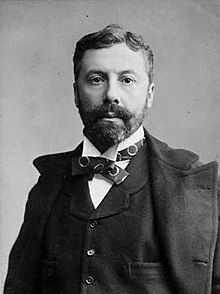
Richard D'Oyly Carte
Richard D'Oyly Carte (; 3 May 1844 – 3 April 1901) was an English talent agent, theatrical impresario, composer, and hotelier during the latter half of the Victorian era. He built two of London's theatres and a hotel empire, while also establishing an opera company that ran continuously for over a hundred years and a management agency representing some of the most important artists of the day.
Carte started his career working for his father, Richard Carte, in the music publishing and musical instrument manufacturing business. As a young man he conducted and composed music, but he soon turned to promoting the entertainment careers of others through his management agency. Carte believed that a school of wholesome, well-crafted, family-friendly, English comic opera could be as popular as the risqué French works dominating the London musical stage in the 1870s. To that end he brought together the dramatist W. S. Gilbert and composer Arthur Sullivan and nurtured their collaboration on a series of thirteen Savoy operas. He founded the D'Oyly Carte Opera Company and built the state-of-the-art Savoy Theatre to host the Gilbert and Sullivan operas. (Full article...) -
Image 9
The Sands Hotel and Casino was a historic American hotel and casino on the Las Vegas Strip in Paradise, Nevada, United States, that operated from 1952 to 1996. Designed by architect Wayne McAllister, with a prominent 56-foot (17 m) high sign, the Sands was the seventh resort to open on the Strip. During its heyday, it hosted many famous entertainers of the day, most notably the Rat Pack and Jerry Lewis.
The hotel was established in 1952 by Mack Kufferman, who bought the LaRue Restaurant which had opened a year earlier. The hotel was opened on December 15, 1952, as a casino and hotel with 200 rooms. The hotel rooms were divided into four two-story motel wings, each with fifty rooms, and named after famous race tracks. Crime bosses such as Doc Stacher and Meyer Lansky acquired shares in the hotel and attracted Frank Sinatra, who made his performing debut at Sands in October 1953. Sinatra later bought a share in the hotel himself. In 1960, the classic caper film Ocean's 11 was shot at the hotel, and it subsequently attained iconic status, with regular performances by Sinatra, Dean Martin, Jerry Lewis, Sammy Davis Jr., Red Skelton and others in the hotel's world-renowned Copa Room. (Full article...) -
Image 10
The Beverly Hills Hotel, also called the Beverly Hills Hotel and Bungalows, is located on Sunset Boulevard in Beverly Hills, California. One of the world's best-known hotels, it is closely associated with Hollywood film stars, rock stars, and celebrities. The hotel has 210 guest rooms and suites and 23 bungalows and the exterior bears the hotel's signature pink and green colors.
The Beverly Hills Hotel was established in May 1912, before the city itself was incorporated. The original owners were Margaret J. Anderson, a wealthy widow, and her son, Stanley S. Anderson, who had been managing the Hollywood Hotel. The original hotel was designed by Pasadena architect Elmer Grey in the Mediterranean Revival style. From 1928 to 1932, the hotel was owned by the Interstate Company. In 1941, Hernando Courtright, a vice president of the Bank of America, purchased the hotel with friends including Irene Dunne, Loretta Young, and Harry Warner. Courtright established the Polo Lounge, which is considered to be one of the premier dining spots in Los Angeles, hosting entertainers ranging from the Rat Pack to Humphrey Bogart and Marlene Dietrich. The hotel was first painted its famous pink color during a 1948 renovation to match that period's country club style. The following year, architect Paul Williams added the Crescent Wing. (Full article...) -
Image 11Façade of Watson's hotel, now known as the Esplanade Mansion
Watson's Hotel (actually Watson's Esplanade Hotel), now known as the Esplanade Mansion, located in the Kala Ghoda area of Mumbai (Bombay), is India's oldest surviving cast iron building. It is probably the oldest surviving multi-level fully cast-iron framed building in the world, being three years earlier than the Menier Chocolate Factory in Noisiel, France, which are both amongst the few ever built. Named after its original owner, John Watson, the cast and wrought iron structure of the building was prefabricated in England, and it was constructed between 1867 and 1869.
The hotel was leased on 26 August 1867 for the terms of 999 years at yearly rent of Rupees 92 and 12 annas to Abdul Haq. It was closed in the 1960s and was later subdivided and partitioned into smaller cubicles that were let out on rent as homes and offices. Neglect of the building has resulted in decay and, despite its listing as a Grade II–A heritage structure, the building is now in a dilapidated state. A documentary film about the building was made in 2019 called The Watson's Hotel. (Full article...) -
Image 12
The Paramount Hotel (formerly the Century-Paramount Hotel) is a hotel in the Theater District of Midtown Manhattan in New York City, United States. Designed by architect Thomas W. Lamb, the hotel is at 235 West 46th Street, between Eighth Avenue and Broadway. The Paramount Hotel is owned by RFR Realty and contains 597 rooms. The hotel building, designed in a Renaissance style, is a New York City designated landmark.
The hotel is 19 stories tall and is H-shaped in arrangement, with light courts to the west and east. The north and south faces of the hotel contain numerous setbacks. The facade is made of brick, stone, and terracotta; most of the decorative detail is concentrated on the south facade, along 46th Street. The hotel building contains a double-height colonnade at street level, as well as several terraces above each of the setbacks. The building has a double-height hip roof flanked by mansard roofs. The basement contains an event venue named Sony Hall, which has historically been used as a nightclub and theater. The double-height lobby's design dates to a 1990 renovation by Philippe Starck. (Full article...) -
Image 13

The Desert Inn, also known as the D.I., was a hotel and casino on the Las Vegas Strip in Paradise, Nevada, which operated from April 24, 1950, to August 28, 2000. Designed by architect Hugh Taylor and interior design by Jac Lessman, it was the fifth resort to open on the Strip, the first four being El Rancho Vegas, The New Frontier, Flamingo, and the El Rancho (then known as the Thunderbird). It was situated between Desert Inn Road and Sands Avenue.
The Desert Inn opened with 300 rooms and the Sky Room restaurant, headed by a chef formerly of the Ritz Paris, which once had the highest vantage point on the Las Vegas Strip. The casino, at 2,400 square feet (220 m2), was one of the largest in Nevada at the time. The nine-story St. Andrews Tower was completed during the first renovation in 1963, and the 14-story Augusta Tower became the Desert Inn's main tower when it was completed in 1978 along with the seven-story Wimbledon Tower. The Palms Tower was completed in 1997 with the second and final renovation. The Desert Inn was the first hotel in Las Vegas to feature a fountain at the entrance. In 1997, the Desert Inn underwent a $200 million renovation and expansion, but after it was purchased for $270 million by Steve Wynn in 2000, he decided to demolish it and build the Wynn Las Vegas resort and casino where the Desert Inn once stood, and later, Encore. The remaining towers of the Desert Inn were imploded in 2004. (Full article...) -
Image 14Sauganash Hotel, c. 1830–33 (the smaller building on the left was Chicago's first drug store)
Sauganash Hotel (originally Eagle Exchange Tavern) was a hotel regarded as the first hotel in Chicago, Illinois. Built in 1831, the hotel was located at Wolf Point in the present-day Loop community area at the intersection of the north, south and main branches of the Chicago River. The location at West Lake Street and North Wacker Drive (formerly Market Street) was designated a Chicago Landmark on November 6, 2002. The hotel has changed proprietors often in its twenty-year existence and briefly served as Chicago's first theater. It was named after Sauganash, an interpreter in the British Indian Department. (Full article...) -
Image 15
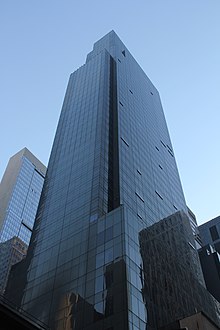
The Millennium Times Square New York (formerly the Hotel Macklowe and the Millennium Broadway) is a hotel at 133 and 145 West 44th Street, between Times Square and Sixth Avenue, in the Theater District of Midtown Manhattan in New York City. Operated by Millennium & Copthorne Hotels, the hotel has 750 guest units, as well as a conference center with 33 conference rooms. The hotel incorporates a Broadway theater called the Hudson Theatre into its base.
The hotel is composed of two guestroom towers flanking the Hudson Theatre. The original 48-story tower west of the theater was designed by William Derman and Perkins & Will, while the 22-story annex east of the theater was designed by Stonehill & Taylor. The original hotel tower contains a lobby with a passageway connecting two entrances on 44th and 45th Streets. In addition, there is a bar, restaurant, and fitness center in the original tower. The conference center in the lower stories extended into the Hudson Theatre, which in 2017 became a Broadway theater. The 22-story annex is branded as the Millennium Premier New York Times Square. (Full article...)
General images - show new batch
-
Image 2A typical hotel room with a bed, desk, and television (from Hotel)
-
Image 3The Star Lite Motel in Dilworth, Minnesota is a typical American 1950s L-shaped motel. (from Motel)
-
Image 8Abandoned Grand West Courts in Chicago, demolished in September 2013 (from Motel)
-
Image 11Sign on Chicago motel (from Motel)
-
Image 12Ice Hotel in Jukkasjärvi, Sweden (from Hotel)
-
Image 13The Boody House Hotel in Toledo, Ohio (from Hotel)
-
Image 14Motels frequently have large pools, such as the Thunderbird Motel on the Columbia River in Portland, Oregon (1973). (from Motel)
-
Image 17Tremont House in Boston, United States, a luxury hotel, the first to provide indoor plumbing (from Hotel)
-
Image 19The Harrison Hotel, an SRO hotel in Oakland, California. (from Apartment hotel)
-
Image 21Wigwam Motel No. 6, a unique motel/motor court on historic Route 66 in Holbrook, Arizona (from Motel)
-
Image 22The Waldorf Astoria New York, the most expensive hotel ever sold, cost US$1.95 billion in 2014. (from Hotel)
-
Image 23The Peninsula New York hotel, located at the corner of Fifth Avenue and 55th Street in Midtown Manhattan (from Hotel)
-
Image 24Holiday Inn's "Great Sign", used until 1982. Some remain in museums. (from Motel)
-
Image 31Burj Al Arab stands on an artificial island from Jumeirah Beach and is connected to the mainland by a private curving bridge (from Hotel)
-
Image 33An apartment hotel in Hammond, Indiana (from Apartment hotel)
-
Image 34Ithaa, the first undersea restaurant at the Conrad Maldives Rangali Island resort (from Hotel)
-
Image 35The 4 Seasons Motel sign in Wisconsin Dells, Wisconsin is an excellent example of googie architecture. (from Motel)
-
Image 36On top of the cliff, the Riosol Hotel in Mogán (from Hotel)
In the news
- 21 January 2025 – 2025 Kartalkaya hotel fire
- Sixty-six people are killed and another 51 injured in a fire at the Grand Kartal hotel in Kartalkaya, Bolu Province, Turkey. (Reuters)
- 2 January 2025 – 2025 New Orleans truck attack, 2025 Las Vegas Trump Hotel bombing
- Christopher Raia, the deputy assistant director of the FBI's counterterrorism division, says he believes that there is "no definitive link" between the two alleged U.S. Army servicemen perpetrators of the attacks, Shamsud-Din Jabbar in New Orleans and Matthew Alan Livelsberger in Las Vegas. (BBC)
- 1 January 2025 – Trump International Hotel Las Vegas Tesla Cybertruck explosion
- A Tesla Cybertruck containing firework mortars and gas canisters explodes outside the Trump International Hotel Las Vegas in Paradise, Nevada, United States, injuring seven people. The driver died from a self-inflicted gunshot prior to the explosion. The Federal Bureau of Investigation (FBI) is currently investigating the incident as a possible terrorist attack. (ABC News)
- 30 December 2024 –
- Three tourists are killed and seven others are injured in a fire at a hotel on Khaosan Road in Bangkok, Thailand. (AP)
- Cuba releases Salvadoran national Raúl Ernesto Cruz León after he completed a 30-year prison sentence for his involvement in the 1997 hotel bombings. (BSS)
- 25 December 2024 –
- A Turkish court sentences the owner and architect of the Grand Isias Hotel in Adıyaman to more than 18 years in prison for negligent homicide after 72 people died when the hotel collapsed in the 2023 earthquakes. (DW)
Selected articles - load new batch
-
Image 1Accor S.A. is a French multinational hospitality company that owns, manages and franchises hotels, resorts and vacation properties. It is the largest hospitality company in Europe, and the sixth largest hospitality company worldwide.
Accor operates 5,584 locations in over 110 countries. Its total capacity is approximately 821,518 rooms (end 2023). It owns and operates brands in many segments of hospitality: Luxury (Raffles, Fairmont, Sofitel), premium (MGallery, Pullman, Swissôtel), midscale (Novotel, Mercure, Adagio), and economy (ibis, hotelF1). Accor also owns companies specialized in digital hospitality and event organization, such as onefinestay, D-Edge, ResDiary, John Paul, Potel & Chabot and Wojo.
The company is headquartered in Issy-les-Moulineaux, France, and is a constituent of the CAC Next 20 index on the Paris stock exchange. (Full article...) -
Image 2
Love hotel in Tokyo, European castle motif
A love hotel is a type of short-stay hotel found around the world operated primarily for the purpose of allowing guests privacy for sex. The name originates from "Hotel Love" in Osaka. Although love hotels exist all over the world, the term "love hotel" is often used to refer specifically to those located within Japan. (Full article...) -
Image 3
Hotel Arctic is a 4-star hotel located 2.7 km north of the Ilulissat Icefjord, a UNESCO World Heritage Site owned by Air Greenland. The hotel was built shortly after the airport was opened in 1984 to accommodate passengers.
Hotel Arctic has 76 rooms, 9 suites and 5 aluminium "Igloos" built on the edge of the coast. The hotel's facilities can accommodate up to 120 people. The restaurant Ulo serves Greenland cuisine and local food.
On September 1, 2013, the hotel was 100 percent CO2-neutral. (Full article...) -
Image 4Britannia Hotels is a British budget hotel group with 64 hotels in Great Britain. The company also owns the Pontins Holiday Parks.
Since 2010 Britannia Hotels has been a subject of criticism over the hygiene and maintenance of its locations; consumer group Which? repeatedly found the chain to be the worst in the United Kingdom since October 2013. The criticism has contributed towards the growing general perception of Britannia Hotels as "Britain's worst hotel chain". (Full article...) -
Image 5Hotel Impossible is a reality television series from Travel Channel in which struggling non-chain hotels receive an extensive makeover by veteran hotel operator and hospitality expert Anthony Melchiorri and his team. The show premiered on April 9, 2012, and ended on November 13, 2017. After airing seven seasons, the series launched a spin-off series called Hotel Impossible: Showdown in which four hoteliers of a pre-selected region that visit and judge each other's establishments for the highest ranking and a prize of $25,000. During season 8, another spin-off series called Hotel Impossible: Five Star Secrets began airing. In it, Melchiorri visits luxury resorts, learns what makes them special, and awards a $5,000 super tip to a deserving staff member. The show was not renewed for a new season in 2018 and is "no longer in active production". (Full article...)
-
Image 6
The Hôtel Mercure Lyon Centre Château Perrache, originally Hôtel Terminus, then Pullman Perrache, then Château Perrache, is a hotel of the AccorHotels group built in 1906. It is located on cours de Verdun in the 2nd arrondissement of Lyon. The hotel was the headquarters for the Gestapo in Lyon during the Second World War. (Full article...) -
Image 7
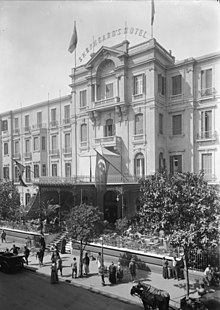
Shepheard's Hotel entrance, c. 1920s
Shepheard's Hotel was the leading hotel in Cairo and one of the most celebrated hotels in the world from the middle of the 19th century until its destruction in 1952 during the Cairo Fire. Five years after the original hotel was destroyed, a new one was built nearby and named the Shepheard Hotel. (Full article...) -
Image 8
The Tropicana Atlantic City, often referred to as The Trop, is a resort, casino hotel located on the beach and Boardwalk in Atlantic City, New Jersey. It is owned by Gaming and Leisure Properties and operated by Caesars Entertainment, and is the third largest hotel in New Jersey, with just under 2,400 guest rooms and the 200,000-square-foot shopping and entertainment complex, The Quarter. It has over 30 restaurants, 30 shops, 20 bars and lounges, 4 pools, the Tropicana Showroom, multiple spas, and an IMAX Theatre. In 2016, Tropicana completed over $200 million in renovations and additions, including a Multimedia Light and Sound Show, the addition of AtlantiCare LifeCenter Fitness (now Tilton Fitness), Garces restaurants, renovations to over 900 hotel rooms, and casino floor but Tropicana will continue investing. The Tropicana is the largest resort and casino on the boardwalk, with 2,364 rooms, 3,000 slot machines, 30 restaurants, and 30 shops, along with two 2,500-space parking garages, totaling over 5,000 parking spaces. In 2021-2023 Tropicana is said to complete renovations through these years, the renovations will include renovations to all 604 West Tower rooms, modernized elevators and escalators, pool enhancements, gaming space enhancements, and more undisclosed renovation projects. (Full article...) -
Image 9

Hotel Ukraine (Ukrainian: Готель Україна), also referred to as Hotel Ukraina or Hotel Ukrayina, is a four-star hotel located in central Kyiv, the capital of Ukraine. It was built in 1961 as the Hotel "Moscow" in a location which originally was occupied by Kyiv's first skyscraper, the Ginzburg House. The construction of the hotel finished the architectural ensemble of Kyiv's main street – the Khreshchatyk – which formed the post-war reconstruction of central Kyiv. (Full article...) -
Image 10

The entrance to Hotel Bora Bora
Hotel Bora Bora was a luxury hotel and resort located on the island of Bora Bora in the Society Islands in French Polynesia. It is currently a part of Aman Resorts. Hotel Bora Bora has been reviewed by Conde Nast Traveler and TripAdvisor. The hotel has over-water bungalows and suites, beach bungalows, garden bungalows with swimming pools (referred to as fare), gardens, and restaurants. The hotel was not reopened after plans for reconstruction, and remains closed. (Full article...) -
Image 11
The Fairmont Banff Springs, formerly and commonly known as the Banff Springs Hotel, is a historic hotel in western Canada, located in Banff, Alberta. The entire town, including the hotel, is situated in Banff National Park, a national park managed by Parks Canada. At an elevation of 1,414 metres (4,640 ft) above sea level, the hotel overlooks a valley towards Mount Rundle, both of which are situated within the Rocky Mountain mountain range.
Opened in 1888 by the Canadian Pacific Railway, it is one of the earliest of Canada's grand railway hotels. The original five-storey wooden hotel was designed by Bruce Price and was able to accommodate 280 guests. With expansions, the original structure became the North Wing, which was eventually destroyed by fire in April 1926.
The present hotel property is made up of several buildings, of which the main hotel consists of a 1914 eleven-storey center tower designed by Walter S. Painter, and a 1927 North Wing and a 1928 South Wing designed by John Orrock which were built on either side of the Center Tower. On 24 June 1988, the hotel buildings were designated as a National Historic Site of Canada. The hotel property is presently managed by Fairmont Hotels and Resorts. (Full article...) -
Image 12
The International Hotel was a hotel located in Virginia City, Nevada. The hotel initially opened as a wooden one-story building in 1860. Two years later, a three-story brick addition was added to the hotel. The wooden portion was dismantled in 1863, and was used to construct a new International Hotel in Austin, Nevada, where it remained operational as of 2014. A four-story brick addition took the place of the wooden building.
The International Hotel burned down in the "Great Fire of 1875". A new International Hotel began construction the following year, and opened with 160 rooms on March 31, 1877. At six stories, the hotel was the tallest building in Nevada until a fire destroyed it in December 1914. The site of the former hotel became a parking lot. (Full article...) -
Image 13

Canopy by Hilton, or Canopy, is a hotel brand by Hilton, announced in October 2014 with the first property opening in Iceland in July 2016, and two in the United States in early 2018. Canopy is Hilton's twelfth brand. On December 31, 2019, there were 13 locations with 2,104 rooms in 5 countries and territories, including three that are managed with 529 rooms and ten that are franchised with 1,575 rooms. As of 2024, Canopy has 45 locations in 12 countries. (Full article...) -
Image 14

Howard Johnson by Wyndham, still commonly referred to as Howard Johnson's, is an American hotel brand with over 200 hotels in 15 countries. It was also formerly a restaurant chain, which at one time was the largest in the U.S., with more than 1,000 locations. Since 2006, all hotels and company trademarks, including those of the defunct restaurant chain, have been owned by Wyndham Hotels and Resorts.
Howard Johnson's restaurants originally started as a single location opened by Howard Deering Johnson in 1925 and grew into a substantial restaurant chain in the decades that followed. By the 1950s, the company expanded operations by opening hotels, then known as Howard Johnson's Motor Lodges, which were often located next to restaurants. Throughout the 1960s and 1970s, it had become the largest restaurant chain in the U.S., with its combined company-owned and franchised outlets.
Howard Johnson's restaurants were franchised separately from the hotel brand beginning in 1986 but, in the years that followed, severely dwindled in number until eventually disappearing altogether. The last restaurant, in Lake George, New York, closed in 2022. The line of branded supermarket frozen foods, as well as its famous ice cream, is no longer manufactured. (Full article...) -
Image 15
The Boots Motel, a historic U.S. Route 66 motor hotel in Carthage, Missouri, opened in 1939 as the Boots Court at 107 S. Garrison Avenue.
It served travellers at the "crossroads of America" (US 66 and U.S. Route 71, the major roads of that era) and was built in streamline moderne and art deco architectural style, its roofline and walls accented in black Carrara glass and green neon. Arthur and Ilda Boots originally advertised "a radio in every room" and each room included a covered carport.
A filling station briefly operated at the front of the property when it opened during the Great Depression but was soon replaced by the motel's office. (Full article...)
Did you know (auto-generated)

- ... that New York City's Mansfield Hotel was developed by two neighbors from Vermont, one of whom later served as Vermont's governor?
- ... that in 1967 Hilton Hotels revealed plans for a 100-room hotel on the Moon?
- ... that the lobby of the Royalton Hotel was once compared to an ocean liner?
- ... that in 1987, an estimated one-sixth of New York City's homeless children lived at the Martinique Hotel, even though it lacked basic facilities like kitchens?
- ... that when the former Clarence Hotel in Brighton began to collapse in 1990, the resulting closure of North Street diverted 120 buses per hour in each direction for a week?
- ... that the Piedmont Hotel hosted a former, a current, and a future U.S. president in one week?
- ... that Harry Steele purchased the Albatross Hotel in a bankruptcy sale and ultimately owned it for over half a century until his death?
- ... that American lawyer and politician Armistead Abraham Lilly was also a principal owner of Ruffner Hotel in Charleston, West Virginia, and resided in its penthouse?
Related portals
WikiProjects
List articles

- Historic Hotels of America
- List of largest hotels
- List of largest hotels in Europe
- List of tallest hotels
- List of casino hotels
- List of chained-brand hotels
- List of defunct hotel chains
- List of hotels in the Caribbean
- List of caravanserais
- Lists of hotels
- List of motels
- Lists of hotels by country (category page)
- Lists of hotels by city (category page)
Topics
|
| ||||||||||||||||||||||||||||||||||||||||||||||||||||||||||||||||||||||||||||||||||||||||||||||||||||||||||||||||||||||||||||||||||||||||||||||||||||||||||||||||||||||||||||||||||||||||||||||||||||||||||||||||||||||||||||||||||||||||||||||||||||||||||||||||||||||||||
Categories
Associated Wikimedia
The following Wikimedia Foundation sister projects provide more on this subject:
-
Commons
Free media repository -
Wikibooks
Free textbooks and manuals -
Wikidata
Free knowledge base -
Wikinews
Free-content news -
Wikiquote
Collection of quotations -
Wikisource
Free-content library -
Wikiversity
Free learning tools -
Wiktionary
Dictionary and thesaurus
More portals
- Pages with Spanish IPA
- All manually maintained portal pages
- Portals with triaged subpages from July 2022
- All portals with triaged subpages
- Portals with named maintainer
- Automated article-slideshow portals with 41–50 articles in article list
- Automated article-slideshow portals with 201–500 articles in article list
- Portals needing placement of incoming links





